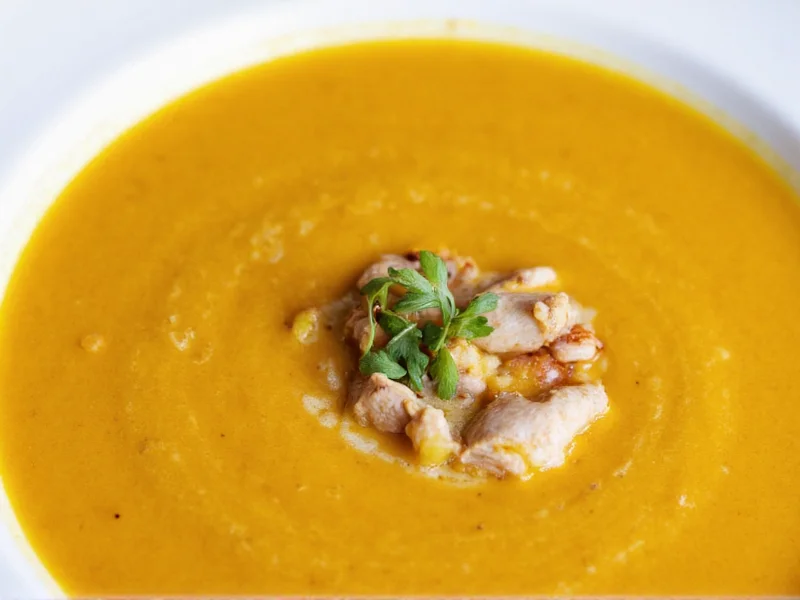Creating exceptional chicken and butternut squash soup requires understanding the science behind flavor development and texture control. Unlike basic recipes that simply blend cooked squash with broth, professional results come from caramelizing the squash first to concentrate its natural sugars, then deglazing the pan to capture those flavor compounds. The ideal ratio of roasted squash to quality chicken broth creates a velvety base without needing heavy cream, making this healthy chicken and butternut squash soup both nutritious and satisfying.
Essential Ingredients and Their Purpose
Every component serves a specific function in achieving balanced flavor and texture:
| Ingredient | Function | Professional Tip |
|---|---|---|
| Butternut squash (2 lbs) | Provides natural sweetness and creamy texture | Roast at 400°F until deeply caramelized at edges |
| Chicken thighs (1.5 lbs) | Rich flavor and tender texture that holds up during cooking | Brown skin-side down first for maximum flavor development |
| Yellow onion (1 large) | Flavor foundation and natural sweetness | Cook until completely translucent before adding garlic |
| Fresh sage (3 tbsp) | Earthy complement to squash's sweetness | Add half while cooking, reserve half for finishing |
| Low-sodium chicken broth (4 cups) | Flavor carrier and soup base | Use homemade or heat commercial broth before adding |
Step-by-Step Preparation Guide
Follow this easy chicken butternut squash soup recipe for restaurant-quality results at home:
- Prepare the squash: Peel, seed, and cube squash into 1-inch pieces. Toss with 2 tbsp olive oil, salt, and pepper. Roast at 400°F for 25-30 minutes until fork-tender and caramelized at edges.
- Brown the chicken: Pat chicken thighs dry and season with salt and pepper. Heat 1 tbsp oil in Dutch oven over medium-high heat. Brown chicken skin-side down for 6-7 minutes until golden. Remove and set aside.
- Build flavor base: In same pot, sauté diced onion until translucent (5-7 minutes). Add minced garlic and 1.5 tbsp chopped sage, cooking 1 minute until fragrant.
- Combine components: Return chicken to pot with any accumulated juices. Add roasted squash and 4 cups warm chicken broth. Bring to gentle simmer.
- Final cooking: Cover and simmer 20 minutes until chicken reaches 165°F internally. Remove chicken, shred, and return to pot.
- Texture refinement: For creamy texture without dairy, blend 2 cups soup mixture until smooth, then return to pot. Adjust seasoning with salt, pepper, and remaining sage.
Pro Tips for Perfect Results
Achieve consistently excellent creamy chicken butternut squash soup with these professional techniques:
- Squash selection: Choose squash with uniform beige color and heavy weight for size, indicating dense flesh. Avoid those with soft spots or blemishes.
- Texture control: Never boil vigorously after adding shredded chicken, which causes the protein to become tough and stringy.
- Flavor balancing: If soup tastes too sweet, add 1 tsp apple cider vinegar. If too savory, stir in 1 tsp maple syrup.
- Dairy alternative: For richer chicken butternut squash soup with coconut milk, substitute 1 cup broth with full-fat coconut milk.
- Time-saving method: Use pre-cubed squash (1.5 lbs) and rotisserie chicken (2 cups shredded) for a 30-minute version with excellent results.
Avoiding Common Mistakes
Many chicken and butternut squash soup recipes fail due to these preventable errors:
- Under-roasting squash: Raw squash creates a grainy texture. Proper roasting develops complex flavors through caramelization.
- Over-blending: Blending hot soup in standard blenders creates dangerous pressure. Always leave vent open and cover with towel.
- Using breast meat exclusively: Chicken breast dries out during simmering. Thighs provide better texture and flavor absorption.
- Adding cold broth: Cold liquid shocks the system and stops cooking processes. Always warm broth before adding.
- Over-seasoning early: Salt concentration changes during reduction. Season in stages, finalizing after soup has reduced.
Variations for Dietary Needs
Adapt this nutritious chicken butternut squash soup for various dietary requirements:
- Gluten-free: Naturally gluten-free when using certified GF broth. Check labels on all packaged ingredients.
- Keto version: Reduce squash to 1 lb, add 1 cup heavy cream, and include 4 slices chopped bacon for additional fat.
- Vegan adaptation: Substitute chicken with 2 cups cooked chickpeas, use vegetable broth, and add 2 tbsp nutritional yeast for umami.
- Lower sodium: Use homemade broth and omit added salt, relying on herbs and lemon juice for flavor enhancement.
Storage and Reheating Guidelines
Follow these chicken butternut squash soup storage tips for optimal freshness and food safety:
- Refrigeration: Store in airtight container for up to 4 days. The soup thickens when chilled—add broth when reheating.
- Freezing: Freeze in portion-sized containers for up to 3 months. Leave 1-inch headspace for expansion.
- Reheating: Warm gently over medium-low heat, stirring frequently. Never boil rapidly, which breaks down texture.
- Revitalizing leftovers: Stir in 2 tbsp fresh lemon juice and additional herbs when reheating to refresh flavors.
Serving Suggestions for Maximum Enjoyment
Elevate your chicken butternut squash soup for cold weather with these presentation techniques:
- Texture contrast: Top with toasted pumpkin seeds or crumbled bacon for satisfying crunch.
- Color enhancement: Drizzle with basil oil or swirl of coconut cream before serving.
- Bread pairing: Serve with crusty sourdough or rosemary focaccia for ideal dipping.
- Meal composition: Pair with simple green salad and protein-rich side for complete meal.











 浙公网安备
33010002000092号
浙公网安备
33010002000092号 浙B2-20120091-4
浙B2-20120091-4